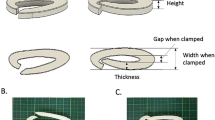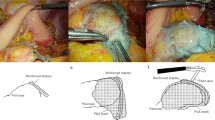Abstract
Background
Two-staged pancreatoduodenectomy with exteriorization of pancreatic juice is a safe procedure for high-risk patients. However, two-staged pancreatoduodenectomy requires complex re-laparotomy and adhesion removal. We analyzed whether using hyaluronate carboxymethylcellulose-based bioresorbable membrane (HCM) reduced the time required for the second operation and facilitated good fistula formation in two-staged pancreatoduodenectomy.
Methods
Between April 2011 and December 2018, data were collected from 206 consecutive patients who underwent two-staged pancreatoduodenectomy. HCM has been used for all patients since 2015. Patients for whom HCM was used (HCM group; n = 61) were compared to historical controls (before 2015) without HCM (control group; n = 145) in terms of feasibility of the second operation (operation time, adhesion grade, and complications) and optimal granulation around the external tube at the second laparotomy.
Results
The HCM group showed significantly shorter median operation time [105 min (30–228 min) vs. 151 min (30–331 min); p < 0.001] and smaller median blood loss [36 mL (8–118 mL) vs. 58 mL (12–355 mL); p < 0.001] for the second operation. Neither overall postoperative complication rate (p = 0.811) nor severe-grade complication rate (p = 0.857) differed significantly. Both groups showed good fistula formation, with no significant difference in rate of optimal fistula formation (HCM group, 95.1% vs. control, 95.9%; p = 0.867).
Conclusion
HCM placement significantly improved safety and duration for the second operation, while preserving good fistula formation.



Similar content being viewed by others
References
Coleman MG, McLain AD, Moran BJ (2000) Impact of previous surgery on time taken for incision and division of adhesions during laparotomy. Dis Colon Rectum 43(9):1297–1299
Hayashi S, Takayama T, Masuda H et al (2008) Bioresorbable membrane to reduce postoperative small bowel obstruction in patients with gastric cancer: a randomized clinical trial. Ann Surg. 247(5):766–770
Kawamura H, Yokota R, Yokota K et al (2010) A sodium hyaluronate carboxymethylcellulose bioresorbable membrane prevents postoperative small-bowel adhesive obstruction after distal gastrectomy. Surg Today 40(3):223–227
Hashimoto D, Hirota M, Yagi Y et al (2012) Hyaluronate carboxymethylcellulose-based bioresorbable membrane (Seprafilm) reduces adhesion under the incision to make unplanned re-laparotomy safer. Surg Today 42(9):863–867
Inoue M, Uchida K, Miki C et al (2005) Efficacy of Seprafilm for reducing reoperative risk in pediatric surgical patients undergoing abdominal surgery. J Pediatr Surg 40(8):1301–1306
Tang CL, Seow-Choen F, Fook-Chong S et al (2003) Bioresorbable adhesion barrier facilitates early closure of the defunctioning ileostomy after rectal excision: a prospective, randomized trial. Dis Colon Rectum 46(9):1200–1207
Salum M, Wexner SD, Nogueras JJ et al (2006) Does sodium hyaluronate- and carboxymethylcellulose-based bioresorbable membrane (Seprafilm) decrease operative time for loop ileostomy closure? Tech Coloproctol 10(3):187–190
Dupré A, Lefranc A, Buc E et al (2013) Use of bioresorbable membranes to reduce abdominal and perihepatic adhesions in 2-stage hepatectomy of liver metastases from colorectal cancer: results of a prospective, randomized controlled phase II trial. Ann Surg 258(1):30–36
Shimizu A, Hasegawa K, Masuda K et al (2018) Efficacy of hyaluronic acid/carboxymethyl cellulose-based bioresorbable membranes in reducing perihepatic adhesion formation: a prospective cohort study. Dig Surg 35(2):95–103
Seyama Y, Kubota K, Kobayashi T et al (1998) Two-staged pancreatoduodenectomy with external drainage of pancreatic juice and omental graft technique. J Am Coll Surg 187(1):103–105
Hasegawa K, Kokudo N, Sano K et al (2008) Two-stage pancreatojejunostomy in pancreaticoduodenectomy: a retrospective analysis of short-term results. Am J Surg. 196(1):3–10
Aoki T, Sakamoto Y, Kohno Y et al (2018) Hepatopancreaticoduodenectomy for Biliary Cancer: Strategies for Near-zero Operative Mortality and Acceptable Long-term Outcome. Ann Surg 267(2):332–337
Callery MP, Pratt WB, Kent TS et al (2013) A prospectively validated clinical risk score accurately predicts pancreatic fistula after pancreatoduodenectomy. J Am Coll Surg 216(1):1–14
Mungroop TH, Klompmaker S, Wellner UF et al (2019) Updated alternative fistula risk score (ua-FRS) to include minimally invasive pancreatoduodenectomy: pan-European validation. Ann Surg. Feb 13 in press.
Kakita A, Takahashi T, Yoshida M et al (1996) A simpler and more reliable technique of pancreatojejunal anastomosis. Surg Today 26(7):532–535
Zühlke HV, Lorenz EM, Straub EM, et al. (1990) Pathophysiology and classification of adhesions. Langenbecks Arch Chir Suppl II Verh Dtsch Ges Chir. 1009–1016.
Dindo D, Demartines N, Clavien PA (2004) Classification of surgical complications: a new proposal with evaluation in a cohort of 6336 patients and results of a survey. Ann Surg 240(2):205–213
Bassi C, Marchegiani G, Dervenis C et al (2017) The 2016 update of the International Study Group of Pancreatic Surgery (ISGPS) definition and grading of postoperative pancreatic fistula: 11 Years After. Surgery. 161(3):584–591
Wente MN, Veit JA, Bassi C et al (2007) Postpancreatectomy hemorrhage (PPH): an International Study Group of Pancreatic Surgery (ISGPS) definition. Surgery. 142(1):20–25
Uchida K, Urata H, Mohri Y et al (2005) Seprafilm does not aggravate intraperitoneal septic conditions or evoke systemic inflammatory response. Surg Today 35(12):1054–1059
Meng G, Xing Q, Yuan Q et al (2014) Internal compared with external drainage of pancreatic duct during pancreaticoduodenectomy: a retrospective study. Chin J Cancer Res 26(3):277–284
Liu FB, Chen JM, Geng W et al (2015) Pancreaticogastrostomy is associated with significantly less pancreatic fistula than pancreaticojejunostomy reconstruction after pancreaticoduodenectomy: a meta-analysis of seven randomized controlled trials. HPB (Oxford). 17(2):123–130
Schindl M, Függer R, Götzinger P et al (2018) Randomized clinical trial of the effect of a fibrin sealant patch on pancreatic fistula formation after pancreatoduodenectomy. Br J Surg 105(7):811–819
Kojima T, Niguma T, Watanabe N et al (2018) Modified Blumgart anastomosis with the "complete packing method" reduces the incidence of pancreatic fistula and complications after resection of the head of the pancreas. Am J Surg 216(5):941–948
Funding
Nothing to report.
Author information
Authors and Affiliations
Corresponding author
Ethics declarations
Conflict of interest
The authors declare no conflict of interest.
Additional information
Publisher's Note
Springer Nature remains neutral with regard to jurisdictional claims in published maps and institutional affiliations.
Rights and permissions
About this article
Cite this article
Yamazaki, S., Takayama, T., Mitsuka, Y. et al. Feasibility of Hyaluronate Carboxymethylcellulose-Based Bioresorbable Membrane in Two-Staged Pancreatojejunostomy. World J Surg 44, 902–909 (2020). https://doi.org/10.1007/s00268-019-05253-y
Published:
Issue Date:
DOI: https://doi.org/10.1007/s00268-019-05253-y




